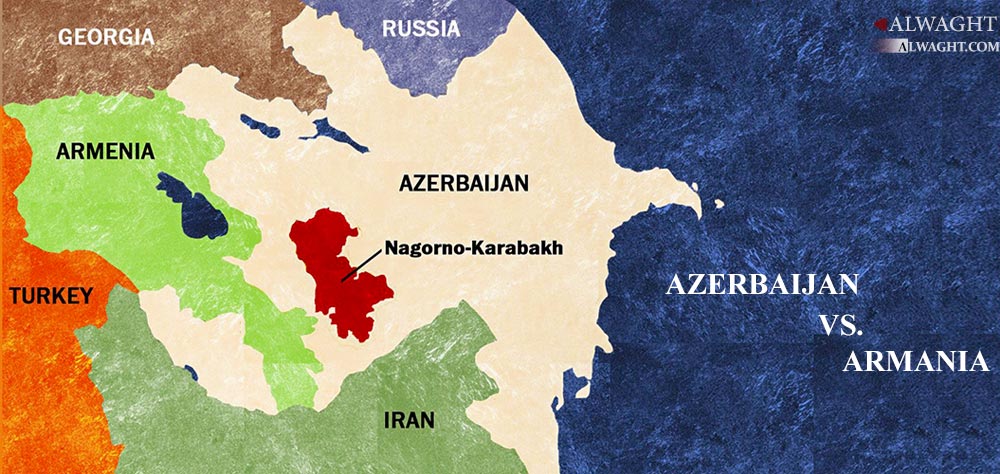Alwaght- A couple of years before the breakup of the Soviet Union, tensions erupted between Armenia and Azerbaijan over the Nagorno-Karabakh region. The collapse of the Soviet Union resulted in a war between the two countries with consequences still impacting the two countries and the region as a whole.
The dispute between the South Caucasian states started in 1988, the year that Armenia made territorial claims against Azerbaijan. The tensions led to a war in 1992 during which the Armenian forces advanced deep into the disputed territories and seized 20 percent of the land there, including the mountainous part of Karabakh and seven other regions. The seizure remains in place to date. The clashes killed at least 30,000 people from both sides and hundreds of thousands of the civilians of the contested region were displaced. The warring sides finally signed a ceasefire deal in 1994, following regional and international mediation. A United Nations Security Council’s resolution has called on Armenia to remove its forces from the mountainous Karabakh and the areas around, an order Yerevan has not complied with to date.
The territorial struggle gave birth to regional blocs. Turkey rose in solidarity with Azerbaijan and encircled Armenia, and on the other side, the Russians supported the Armenians, despite showing some conservatism.
In April 2016 clashes, the deadliest since 1994, nearly 110 civilians and military personnel from two sides of the encounter were killed. A new truce deal was brokered by the Russians and was signed in Moscow shortly after, but the sporadic clashes remain active on the border lines.
However, despite efforts made by influential parties in the issue, the Karabakh crisis remains. The current challenge now lies in two issues: First, Baku is not poised to recognize the independence of Karabakh region. Second, the Armenian government by no means agrees with Karabakh going under the rule of Azerbaijan. Certainly, as long as no side is inclined to make compromises and step back from their stiff stances, no solution is in sight to the decades-long dispute.
Lack of end to the crisis does not mean that Baku and Yerevan have not engaged in peace negotiations with each other. In fact, failure to finish the case should be also blamed on the conflict of interests of the superpowers, something so far prevented Azerbaijan and Armenia from making tangible steps towards peace.
In the very recent development, the foreign ministers of Azerbaijan and Armenia met on Thursday in Krakow, Poland. The meeting, the news reports said, focused on the unresolved issues between the neighbors. The important point about the January 18 meeting is the attendance of the co-chairs of the OSCE (Organization for Security and Cooperation in Europe)-Minsk Group, an organization that despite massive pro-peace efforts has not been successful in finding a settlement for one of the most significant crises of the South Caucasus region. The attempts to settle the Karabakh dispute go on while Russia, a party possibly with the greatest role in the crisis, earlier cast doubt on the feasibility of the dispute settlement. The Russians encourage more efforts towards a de-confliction deal but are wary of extra-optimism about a rapid solution to this regional territorial dispute.
The European officials of the OSCE have reiterated that ending the ethnic disputes in Georgia and Moldova, and territorial dispute of Karabakh is high on its agenda. Italy, the current president of the OSCE, has maintained that in 2018 the negotiations between the OSCE’s members will be sped up, adding that the Karabakh dispute will be given a special concentration. The Italian chair of the OSCE said the humanitarian aspects of the Karabakh struggle are one of the serious concerns of Europe.
Anyway, the multi-party talks on a peaceful solution for Karabakh region are gaining international attention anew, with the influential parties like Europe and Russia are intending to discuss the case more. A set of challenges such as complexity of the crisis and interconnection of the superpowers’ interests make it hard to see any promising outlook for a solution. The 2017 began with a prediction by the former US envoy to the Karabakh crisis. He predicted that Baku and Yerevan will engage in the fight again, after the April 2016 week-long clashes. The International Crisis Group on Karabakh on January 1, 2017, warned that risks of conflict between Baku and Yerevan remain active because both sides show fresh backgrounds for confrontation. Despite all of the pessimistic predictions for the Azerbaijani-Armenian relations in 2017, the situation remained calm, with the border incidents being less in comparison to the year before.
Resumption of the diplomatic ties from the second half of the same year signaled the two countries’ will to cease the military conflict against each other. Still, there is no precondition for a final agreement or a mechanism for a lasting ceasefire. Azerbaijan kept a mix of military superiority advantage and discontentment with the status quo. On the side of Armenia, 2018 is a year of transition from the presidential to the parliamentary system of governance. The country will also hold its presidential election in the same year. The previous years’ experiences suggest that tensions and military encounters between the two countries subsided in the years that they hold elections. The same thing is expected to take place in the current year, as this trend of armed peace is predicted to continue standing.



























